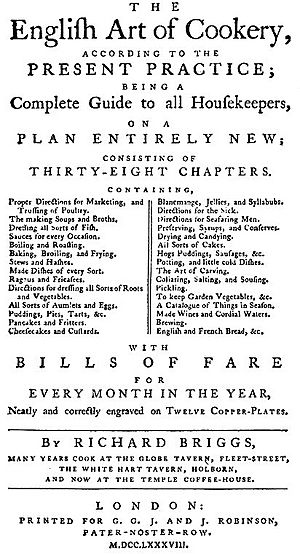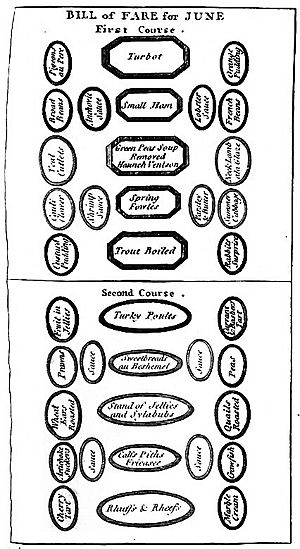The English Art of Cookery facts for kids
The English Art of Cookery is an old cookery book from 1788. It was written by Richard Briggs, a cook who worked in taverns in England. This book teaches you how to make many kinds of English dishes.
The book includes recipes for interesting foods like "toad in a hole" (which is a meat dish, not a real toad!), mushroom ketchup, and puff pastry. It also shows how Indian cooking started to influence English food back then.
Contents
About the Author and His Book
Richard Briggs was a well-known cook in his time. He worked at famous places like the Globe Tavern in Fleet Street and the White-Hart Tavern in Holborn. Later, he worked at the Temple Coffeehouse.
What the Book Was For
Briggs named his book The English Art of Cookery according to the present practice; being a complete guide to all housekeepers on a plan entirely new. In his introduction, he explained that he wrote it for everyday cooks and servants, not for very rich people. He wanted his instructions to be easy to understand and follow. He said he worked hard to make the recipes simple for anyone to use.
Even though it was for everyday cooks, the book was quite expensive for its time. It cost 7 shillings, which was a lot of money back in 1788.
A Mix of Flavors
This cookbook had many French recipes, more than most English cookbooks of that time. You could find dishes with French names like "Poulet a la Braize" (braised chicken) and "Soup a la Reine" (Queen's soup).
But it also had classic English foods, like "toad in a hole." Briggs's version of "toad in a hole" used beef and spices like ginger and nutmeg, not sausages.
The book also showed how food from India was starting to become popular in England. For example, in the chapter about pickling, there were recipes for "Mock Ginger" and "Melon Mangoes." Briggs even gave recipes for chicken and veal curries, telling cooks to use "curric powder" (which we now call curry powder).
How the Book Is Organized
The book is very well organized. It has 38 chapters, and each chapter focuses on a different type of cooking or food. Many chapters start with "Proper rules to be observed in" that specific cooking area.
Understanding the Recipes
The recipes are given as simple names, like "Oyster Sauce for Fish." Each recipe has a paragraph of instructions. You won't find a list of ingredients at the top like in modern cookbooks.
Instead, the amounts are mentioned within the instructions, like "a pint of large oysters" or "half a pound of butter." The cooking steps rely on the cook watching the food, for example, "boil it up gently till the butter is melted, and the sauce thick and smooth." This means cooks had to pay close attention!
What's Inside the Book
Here are some of the main topics covered in the book's many chapters:
- 1. Marketing (How to buy food)
- 2. Soups
- 3. Fish
- 4. Sauces
- 5. Boiling
- 6. Roasting
- 7. Baking
- 8. Broiling (Grilling)
- 9. Frying
- 10. Stews and Hashes
- 11. Made Dishes (Complex meals)
- 12. Ragous (Rich stews)
- 13. Fricasees (Stewed or fried meat dishes)
- 14. Roots and Vegetables
- 15. Aumlets and Eggs, Cheese
- 16. Puddings
- 17. Pies, Pettit Patties, Tarts, Tartlets, and Puffs
- 18. Pancakes and Fritters
- 19. Cheesecakes and Custards
- 20. Blancmange, Creams, and Flummery (Desserts)
- 21. Jellies and Syllabubs (Desserts)
- 22. Directions for those that attend the Sick (Food for ill people)
- 23. Directions for Seafaring Men (Food for sailors)
- 24. Preserving
- 25. Syrups and Conserves
- 26. Drying and Candying
- 27. Cakes
- 28. Hogs Puddings, Sausages, &c.
- 29. Potting (Preserving meat in pots), Little Cold Dishes
- 30. Carving
- 31. Collaring (Rolling and tying meat)
- 32. Salting and Sousing (Preserving with salt or vinegar)
- 33. Pickling
- 34. To Keep Garden Vegetables and Fruits, A Catalogue of Fish, Game, Poultry, Fruit, and Garden Vegetables, in Season every Month in the Year
- 35. Wines
- 36. Cordial Waters (Flavored drinks)
- 37. Brewing (Making beer)
- 38. Baking
Pictures in the Book
The book had 12 special pictures, called copper-plate engravings. These pictures showed "Bills of Fare" for each month of the year. A "Bill of Fare" was like a menu or a plan for a meal, showing how different dishes would be arranged on a table. These pictures were placed before the first chapter of the book.
Interesting Recipes
In the 1700s, people in England ate many different kinds of birds. Briggs's book taught cooks how to roast birds like Ruffs and Reeves from Lincolnshire, Ortolan buntings, larks, plovers, and wheatears. It also included recipes for wild ducks, woodcocks, and snipes.
The book also had recipes for ketchups made from mushrooms or walnuts. And it showed how to make puff pastry, which Briggs used for both sweet and savory dishes.
Different Versions of the Book
The English Art of Cookery was very popular and was printed many times. Here are some of its editions:
- 1788: First Edition, published in London
- 1790?: Published in Cork, Ireland
- 1791: Second Edition, London
- 1791: Published in Dublin, Ireland
- 1792: Published in Philadelphia, USA, with a new title: The New Art of Cookery
- 1794: Third Edition, London
- 1798: Published in Dublin, Ireland
- 1798: Second American Edition, Boston, USA
- 1806: Published in Dublin, Ireland




